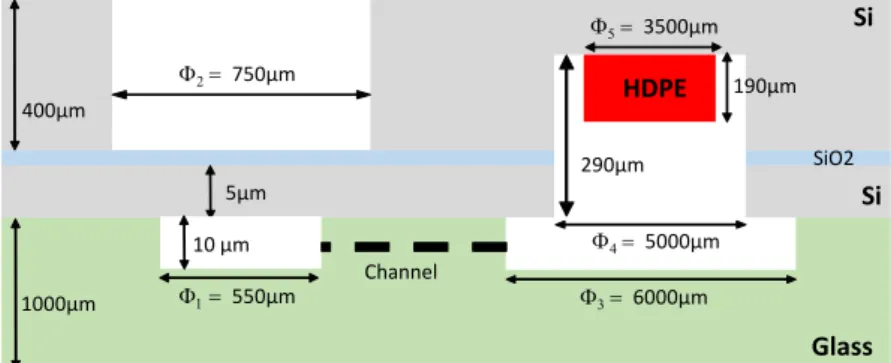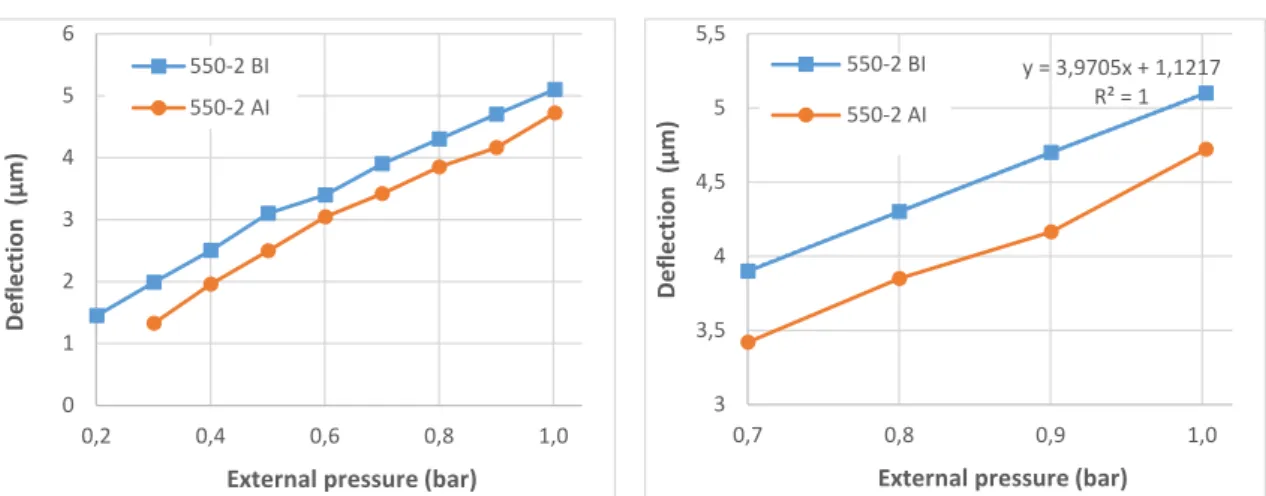HAL Id: hal-01852434
https://hal.laas.fr/hal-01852434
Submitted on 1 Aug 2018HAL is a multi-disciplinary open access
archive for the deposit and dissemination of sci-entific research documents, whether they are pub-lished or not. The documents may come from teaching and research institutions in France or abroad, or from public or private research centers.
L’archive ouverte pluridisciplinaire HAL, est destinée au dépôt et à la diffusion de documents scientifiques de niveau recherche, publiés ou non, émanant des établissements d’enseignement et de recherche français ou étrangers, des laboratoires publics ou privés.
Polyethylene Outgassing Study for MEMS Nuclear
Radiation Sensor
Dheeraj Kumar, Julien Philippe, Samuel Charlot, Sandrine Assié-Souleille,
Aurélie Lecestre, André Ferrand, Hervé Aubert, Patrick Pons
To cite this version:
Dheeraj Kumar, Julien Philippe, Samuel Charlot, Sandrine Assié-Souleille, Aurélie Lecestre, et al.. Polyethylene Outgassing Study for MEMS Nuclear Radiation Sensor. Eurosensors 2018, Sep 2018, Graz, Austria. pp.9 - 12. �hal-01852434�
Proceedings 2018, 2, x; doi: www.mdpi.com/journal/proceedings
Proceedings
Polyethylene Outgassing Study for MEMS Nuclear
Radiation Sensor
D. Kumar1,2,†, J. Philippe2 , S. Charlot2 , S. Assié2 ,A. Lecestre2, A. Ferrand1,2 , H. Aubert2 and
P. Pons2*
1 ICA, Université de Toulouse, Toulouse, France
2 LAAS-CNRS, Université de Toulouse, CNRS, INP, Toulouse, France
Emails: dkumar@laas.fr, jphilipp@laas.fr, scharlot@laas.fr, sassie@laas.fr, alecestre@laas.fr, andre.ferrand@insa-toulouse.fr, aubert@laas.fr
* Correspondence: ppons@laas.fr, 33-5-61-33-64-63
† Presented at the Eurosensors 2018 Conference, Graz, Austria, 9–12 September 2018. Published: date (leave it empty)
Abstract: In this paper, the out-gassing from PolyEthylene (PE) film is studied under nuclear
irradiation for the design and fabrication of passive MEMS dosimeters. The fabrication of sensor needs high temperature process that leads to specific constraints on the PE film. Radiation chemical yield of hydrogen production (GH2) from PE under gamma irradiation is verified by mass spectroscopy after temperature annealing in vacuum up to 400°C. Prototypes are fabricated to validate the fabrication of the sensor and then irradiated with high energy gamma radiation (with dose of 20 kGy). Measurements of membrane deflections after irradiation validate the GH2 factor, showing low pollution level of PE during sensor fabrication.
Keywords: polyethylene; nuclear radiation sensor; MEMS dosimeters; hydrogen outgassing
1. Introduction
Wireless passive (battery-less) and chip-less (without electronic circuits) sensors present interesting solution for harsh environment applications. In the case of nuclear radiation measurement, such solutions allow real time dose monitoring by remotely interrogating nuclear radiation sensors from radar reader [1].
The operating principle of the sensor is the following: when PolyEthylene (PE) placed inside a hermetic sealed cavity is subjected to nuclear irradiation, an outgassing (mainly of H2 molecules) occurs and generates a pressure on a highly resistive silicon membrane. This lead to the membrane deflection, which modify the resonant frequency of a planar microwave resonator placed just below the membrane. From the measurement of the frequency shift, the nuclear radiation dose is derived. In our previous design (see Figure 1), a double Si/Glass stack was used for the sensor fabrication and leads to a complex technological process and non-sealed cavity for the resonator. The PE was obtained from peeling small ball and the Si/Glass2 bonding was performed under N2 using a non-collective process Moreover, the sensor sensitivity varied significantly from one sensor to another and was about 20 times higher than the simulation results [2]. The possible reason could be the pollution of PE during sensor fabrication leading to the undesirable out-gassing after irradiation. Consequently, in order to control these additional out-gassing of PE, we report here a simple, more reliable and collective technological fabrication process for passive MEMS dosimeters with a new design (see Figure 2). The process uses a simple Si/Glass stack where the calibrated 200µm thick High Density PolyEthylene (HDPE) film and the resonator are sealed inside the same cavity under vacuum. Moreover, the millimeter-wave excitation of the resonator is performed by using a small radiating aperture [1].
Proceedings 2018, 2, x 2 of 4
Figure 1. Previous dosimeter design Figure 2. New dosimeter design
2. Materials and Methods
Prototypes were designed to measure radiation chemical yield of hydrogen production (GH2) from sensing devices fabricated with technological process similar to that used for the final sensors (see Figure 3). The HDPE cavity (5mm diameter and 290µm depth) is etched inside a low resistivity 400µm thick SOI wafer. The H2 out-gassing will provide the deflection of the small silicon membrane (550µm diameter and 5µm thick) that will be monitored with optical profiler.
For GH2 = 4.10-7 mol/J, the pressure Pg generated by the PE is given by equation 1 [2], where VPE and Vg denote respectively the PE volume and the volume of gas expansion:
𝑷𝑷𝒈𝒈[𝑩𝑩𝑩𝑩𝑩𝑩] = 𝟗𝟗. 𝟓𝟓 𝟏𝟏𝟏𝟏−𝟑𝟑 𝑽𝑽𝑷𝑷𝑷𝑷 �𝒎𝒎𝒎𝒎
𝟑𝟑�
𝑽𝑽𝒈𝒈 [𝒎𝒎𝒎𝒎𝟑𝟑] ≅ 𝟏𝟏𝟏𝟏
−𝟐𝟐 𝑽𝑽𝑷𝑷𝑷𝑷 �𝒎𝒎𝒎𝒎𝟑𝟑�
𝑽𝑽𝒈𝒈 �𝒎𝒎𝒎𝒎𝟑𝟑� /𝒌𝒌𝒌𝒌𝒌𝒌 (1) With dimensions given in the Figure 3, Pg ≅ 0.045 bar/10kGy which leads a membrane deflection sensitivity of 0.23µm/10kGy.
Figure 3. Cross section of the prototype for the measurement of GH2
3. Results and discussions
3.1. PE properties
One of the major issue during the technological fabrication of sensors is the use of high temperature silicon/glass anodic bonding that may degrade the H2 out-gassing capabilities of HDPE. The thermo-gravimetric analysis performed under Helium (He) atmosphere shows that the degradation of HDPE occurs only above 400°C (see Figure 4). To provide a security margin, the silicon/glass temperature bonding is then performed at 350°C.
HDPE samples are annealed in vacuum at 350°C and then placed in a sealed glass tube under He atmosphere. After irradiation to gamma rays (137Cs 661.7 keV, dose rate 0.3kGy/h, dose 24kGy), the gas composition analysis is finally performed using a quantitative gas mass spectrometer. It shows that H2 production is not affected by high temperature process (GH2 ≅ 4 10-7 mol / J) [3].
Glass1 Glass2
Silicon
µwave coplanar resonator PE
Silicon
PE
Glass1 Glass2 Small radiating aperture
µstrip line
µwave microstrip resonator
5µm 400µm 10 µm Glass 1000µm Φ1= 550µm Φ3= 6000µm Si HDPE 190µm SiO2 290µm Si Φ2= 750µm Φ4= 5000µm Φ5= 3500µm Channel
Figure 4. Evolution of PE mass versus temperature
3.2. Prototypes fabrication and characterization before irradiation
For silicon wafer fabrication, the two main steps were: (1) the 5µm thick membrane release and (2) the HDPE cavity fabrication with deep reactive ionic etching using 40µm thick photoresist mask. For the glass wafer, the 10µm depth cavity were obtained from etching in hydrofluorydric bath using Chromium/Gold mask.
After 2 minutes annealing at 200°C under vacuum, 200µm HDPE film was cut using a stamping pliers and the 3.5mm diameter samples were placed inside the silicon cavity. Silicon and glass wafer were aligned in AML bonder, heated at 350°C under vacuum during 30min and then bonded at 600V. Prototypes were fabricated using this technological process (see Figure 5). Before silicon/glass bonding, the membrane deflection is small (≅ 0.2µm) and after bonding, the deflection is found to range from 5.1µm to 5.4µm for atmospheric pressure applied on the top of the membrane (see Figure 6). This experimental result is close to the expected value with vacuum inside the cavity (simulated sensitivity was of 5µm/bar). After two weeks, the membrane deflection remains unchanged.
Figure 5. Bottom views of fabricated prototypes
Figure 6. Membrane deflection versus external pressure applied on the top of the membrane (BI : Before Irradiation, AI : After Irradiation)
0 10 20 30 40 50 60 70 80 90 100 50 150 250 350 450 550 Ma ss (% ) Temperature (°C) PE Membrane PE cavity Glass channel Si/Glass interface Si membrane Glass channel PE Si cavity Glass cavity 0 1 2 3 4 5 6 0,2 0,4 0,6 0,8 1,0 Def lec tio n (µm )
External pressure (bar)
550-2 BI 550-2 AI y = 3,9705x + 1,1217 R² = 1 3 3,5 4 4,5 5 5,5 0,7 0,8 0,9 1,0 Def lec tio n (µm )
External pressure (bar)
550-2 BI 550-2 AI
Proceedings 2018, 2, x 4 of 4
As displayed in Figure 6, the membrane sensitivity to pressure variation was also calibrated under pressure between 0.2 bar and 1 bar. For pressure between 0.8 bar and 1 bar, the sensitivity S is around 4 µm/bar.
3.3. Prototypes characterization after irradiation
The prototypes are irradiated to gamma rays (137Cs 661.7 keV, dose rate 0.3kGy/h, dose 20kGy). The membrane sensitivity to pressure was also calibrated 3 weeks after irradiation and we checked that no significant change occurred after irradiation (see Figure 6). For atmospheric pressure, the membrane deflection is reduced by 0.4µm. The pressure Pg generated inside the HDPE cavity after this irradiation can be then derived from equation (2) :
𝑷𝑷𝒈𝒈= ∆𝑷𝑷𝒐𝒐− (∆𝑫𝑫 𝑺𝑺⁄ ) (2)
where ∆Po denote the atmospheric pressure variation between two measurements of membrane deflection, ∆D is the variation of the membrane deflection related to irradiation dose and S designates the membrane sensitivity around 1 bar derived from Figure 6. The pressure Pg is then found to be of 0.05 bar/10kGy and is close to the expected value (simulation results predict a pressure of 0.045 bar/10kGy).
After two weeks, the membrane deflection remains unchanged and consequently, we concluded that a good H2 tightness was achieved.
4. Conclusions
Prototypes based on silicon membrane were designed and fabricated to validate the fabrication process of a passive MEMS dosimeter. After irradiation to gamma rays (20kGy), membrane deflection analysis shows that the radiation chemical yield of hydrogen production (GH2) from HDPE is close to simulation results. So few undesirable out-gassing from polyethylene occurs during prototype irradiation, validating the fabrication process with low level of HDPE pollution.
Acknowledgments: This work was partially funded by CARANUC project (Occitanie Region, France and Europe) and EDF (Electricité de France). This work was partly supported by LAAS-CNRS micro and nanotechnologies platform, members of the French RENATECH network.
Conflicts of Interest: The authors declare no conflict of interest. The founding sponsors had no role in the design of the study; in the collection, analyses, or interpretation of data; in the writing of the manuscript, and in the decision to publish the results.
References
1. C. Arenas et al., Wireless and Passive Nuclear Radiation Sensors, European Microwave Week, 8-13 Oct 2017, Nuremberg, Germany
2. I. Augustyniak et al., Micromechanical high-doses radiation sensor with bossed membrane and interferometry optical detection, Sensor and Actuator, Volume 232, August 2015, Pages 353–358
3. T. Seguchi, Hydrogen yield from polyethylene by radiolysis and the application to dosimeter, Asian-Pacific Symposium on Radiation Chemistry; Shanghai (China); 17-21 Sep 2006
© 2018 by the authors; Licensee MDPI, Basel, Switzerland. This article is an open access article distributed under the terms and conditions of the Creative Commons Attribution (CC BY) license (http://creativecommons.org/licenses/by/4.0/).

